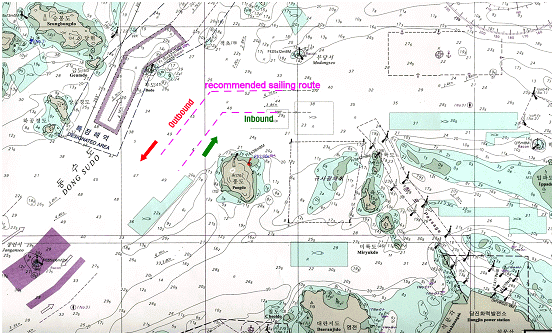Route Recommendation for Safe Traffic
Route Recommendation for Safe Traffic
- Approaches to Pyeongtaek-Dangjin Port has complicated coastal configurations and shallow waters in the vicinity.
- There are Incheon Port to the north of Pyeongtaek-Dangjin Port and Daesan Port to the west.
- So, a large part of approaches is shared by the vessels entering and leaving the three ports, and the sea traffic is sometimes crowded with vessels.
- In order to minimize dangerous crossing situations and to avoid shallow waters, approaching sailing route is recommended as generally shown below.
- Sometimes, owing to fishing nets, the approaches might be restricted. At any case, inbound vessels and outbound vessels shall be maneuvered to keep "port to port rule".
- In order to practice this principle, especially outbound vessels shall keep a wide berth to Pungdo(I.) to give inbound vessels enough room for safe transit. If outbound vessels try short-cut in the vicinity of Pungdo, inbound vessels lose much of navigable water because their starboard sides are shallow waters and their port sides are restricted by outbound vessels. It may result in dangerous collision condition due to unexpected coming close.
-
Please remind;
Every vessel shall keep a port to port rule.
Every vessel shall consider the navigable water of vessels running opposite direction.
Inbound vessels shall keep close to Pungdo as much as practicable.
Outbound vessels shall keep a wide berth to Pungdo as much as practicable.

Above chart extraction is quoted just only for the purpose to help understanding. For actual navigation, updated charts shall be used.


